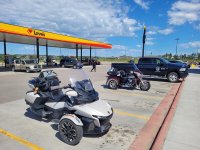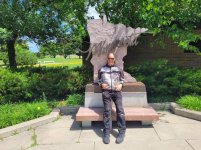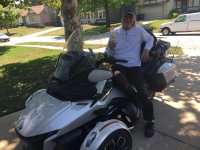Post Trip Reflections
I can’t believe its almost been a week since I completed my Alaska journey. I thought it was time to reflect on the trip before too much time passed.
Pre-Trip Readiness
Canada had been locked down to outside visitors for two years. They lightened up a little in August 2021 but it was still restrictive, by April 2022 there were three things I needed to cross the border as a tourist.
One, I had to have a passport which I already possessed. Two, I needed to have a document/card which showed that I had at least two Covid vaccines, two weeks prior to entering. Three, I had to upload pictures of the passport and Covid document to the ArriveCan app. Once I was within three days of crossing the border, I had to add the border crossing location I would use and where I was going in Canada. I would just put in the hotel address of the first hotel I would be staying in. I would tell the Customs Agent I was going to Alaska. I had to update the border crossing twice, once on the way up to Alaska and again on the way back. It was an easy thing to do. Both times the Border Agent only asked to see my passport. They were not interested in my vaccine card. I don’t know if they could pull up my completed ArriveCan app electronically, but they never asked to see the receipt I had on my phone confirming I had indeed completed the app.
Since I would be in Canada more than Alaska, I did buy a medical coverage policy from World Nomads. This company is used by many adventure riders. The policy was $125 for a month. It was a reimbursement style policy so I would have to pay medical costs upfront and then file a claim. Blue Cross/Blue Shield has a travel policy, but it was $250. Twice as much but it paid for claims upfront.
I upgraded my AAA membership. To get my Spyder covered I had to add the RV coverage. Strange, but it was only an extra $27 a year.
My Spyder is still under warranty.
One thing I did not purchase was a Spot finder/locater. I believed that I would only be in isolated areas for a few days while I was in northern BC and the Yukon. I was wrong. I was in isolated areas almost every day once I got north of Hinton, AB. Eighty miles between gas stops was common. My longest was 150 miles. Even stretches of the Trans-Canada Highway were sparsely populated. If I had mechanical issues, there is no way Can-Am or AAA would have found me in any reasonable time frame, and I would have no way to specifically identify my location. There are no mile markers. So, I would encourage any Alaska rider to consider a Spot tracker/finder or similar item for that just in case moment.
I got a second credit card. The new one has no foreign transaction fees. I used this card exclusively in Canada and used my existing card in the States including Alaska. One time I was on a trip and my credit card was compromised. I had to use my debit card for three days while a new card was being mailed to my home address. Carry two cards, one with no foreign transaction fees if you are a US citizen traveling through Canada. In an odd sort of way, it was nice to pump $10 a gallon gas but only be charged $7.80.
My wife stayed home and served as my base of operations. If you travel with your spouse, it would be wise to have a relative or good friend to serve in this capacity. When I had poor cell service, I could still text her and she would call hotels and make reservations for me. She was invaluable when the Alaska Highway was washed out and she worked on calling hotels along the Cassiar Highway since my phone would lose connection at any time. Fortunately, I didn’t have any physical emergencies or financial issues, but it is nice to have someone at home that can support you.
The Spyder
Readers assumed my Spyder was running well since I never made a negative comment about it. The assumption was true. It ran great. I kept my mouth shut about it so I wouldn’t jinx it. Pre-trip I had 6,000 miles on my 2020 RTL. I went ahead and did the 9K service which included an oil change so I would have the Spyder all checked out. I also replaced the rear tire at Lamonster Garage so it would have good tread throughout the trip. The front tires looked good and have not worn down to the tread wear marker, yet. I bought the Spyder in October 2020, so I still have a factory warranty.
I added a few farkles, not necessarily for the trip, but some turned out to be nice additions. I used my highway pegs every day. The new models don’t fit as well as the older RT models. The new foot pegs should be turned in toward the rider a bit, but they face directly backwards so most of the time my feet were not sitting squarely on the pegs. I had added the BRP adjustable wings to keep the cooler breeze off me. My Hopnel dash bag was convenient to keep eyeglass cleaner, hand sanitizer, gum, tissues, etc. in. I have a top case rack, but I never used it. It was nice to know that I had the extra carrying space if I needed it, but I never did. I installed the KOTT grills and the upper vent grills to keep stray rocks away. Phone and drink holders. I installed a 12V plug in the frunk.
I used a 40L Givi dry bag for my clothes. I carried six days’ worth of clothes in two packing cubes inside the bag. The packing cubes kept things tidy and organized. Dirty clothes I put in the bottom of the dry bag and the clean cubes I placed on top of them. Each week I had a rest day when I would do laundry.
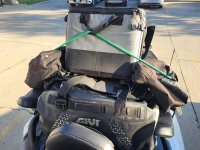
I used two Can-Am brand saddle bag liners in my top case. I stored food items in one (spices, plastic silverware, tortillas, candy, scissors, etc.) and medical and miscellaneous items in the other. After a few days I changed things around and moved anything I use daily to my food bag and kept anything else in the medical bag so I wouldn’t have to bring both bags in every night. I laid them flat, and they fit perfectly. I also had an old Hopnel bag from my old RT and used it for all my electronics. I carried a square outlet extender that also had USB ports and extra charge cords. I also kept my Gerbing batteries and Cardo headset with their respective chargers in the bag, but I never used them. My laptop was placed on top of three bags and there was still room to tuck extra glass cases and drink holders.
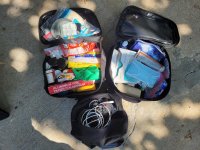
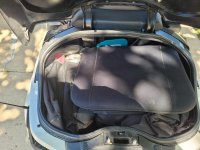
The left saddle bag I carried tools in a Hopnel saddle bag case. This included an air pump, tire plugs, extra oil, fuses, a can of fix-a-flat, and a variety of basic tools. Things like zip ties, common metric tools used on the Spyder, a small wrench, screwdrivers, etc. The only thing I felt comfortable in fixing would be a flat tire, but the extra tools may have come in handy to keep things tightened up or help another rider.
The right saddle bag I kept my rain suit and my half cover. I used the half cover every night except once and that was when my memory foam seat cushion and sheep skin went missing.
The frunk I only filled about halfway with a couple extra clothing layers, the Gerbing jacket liner, my Jacket liner, boots or sneakers and anything else I picked up along the way. I encourage anyone taking a long trip to NOT fill up every available space. You will need it later for things you pick up or when you need a place to store your riding jacket.
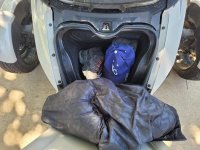
Cooler Bag- I kept a small cooler bag which held three waters, lunch meat, cheese and sometimes cooked chicken or meatballs. I had room in the cooler for about three days’ worth of food. I ate lunch on the road almost every day. I carried tortillas in the food bag in the top case along with mustard and a Ziploc bag of single serving condiments. Two out of three nights I would eat dinner in the hotel room. I only had two hotels that did not have a refrigerator and microwave. Those two hotels also had attached restaurants they wanted you to patronize. My breakfast was usually a protein bar and a quick perusal of the “free” breakfast at my hotel. Keeping my restaurant eating limited I saved a considerable amount of money that I spent on gasoline instead. Besides, there were no restaurants on much of the Alaska Highway. I had two small pouch bags from my kid’s ATV days and I kept snacks like trail mix and jerky in one and cleaning supplies such as a small container of Dawn and microfiber cloths in the other.
Preparing the Rider
I am 65 years old and almost everyone at my age has some type of physical ailment to contend with. I have degenerative and arthritic discs in my neck. I was worried how my neck would hold up supporting a four-pound helmet every day.
I spent three and a half months at the community fitness center getting myself in shape. I also saw a chiropractor to get and keep my spine aligned. After the initial three weeks of twice a week appointments I saw her once a month for the five months leading up to my trip.
I also saw Physical Therapist to continue working on flexibility and strength for my neck. I saw him twice a week for four weeks ahead of the trip.
I had prescription strength lidocaine patches I applied every day on the back of my neck and my wife bought me some KT tape that athletes use to calm over worked muscles. I was quite the sight each morning as I patched and taped myself together. I also took ibuprofen daily and an occasional muscle relaxer at night.
So, my neck did well on the trip. I would have stiffness and some aches most days, but it was not ride compromising. When my upper shoulders started becoming sore, I moved some of my tape and patches lower.
I know I am leaving something out of this recap so please feel free to ask me any questions you may have about my trip or taking a long-distance trip of your own. I am glad I had the experience and the opportunity to share it.
 I have really enjoyed the informative reports. Yesterday was the first time I started reading your posts.
I have really enjoyed the informative reports. Yesterday was the first time I started reading your posts. 
